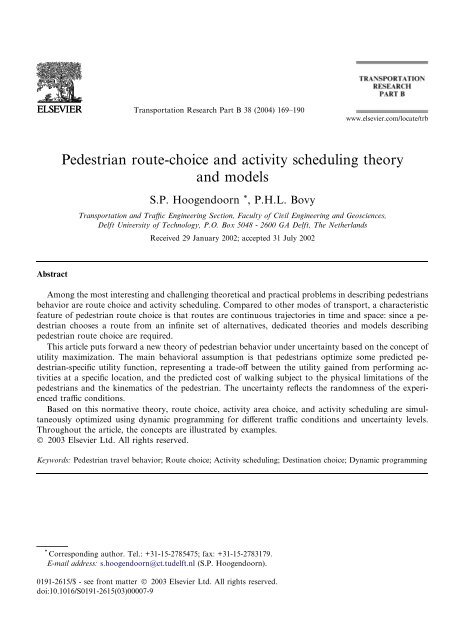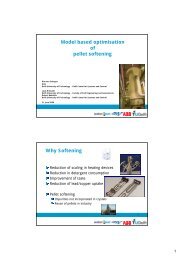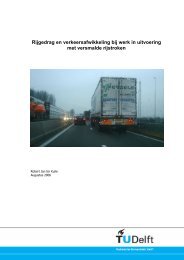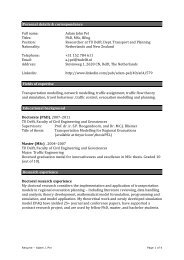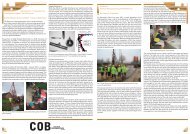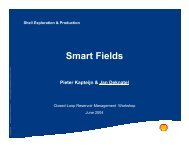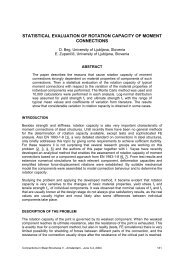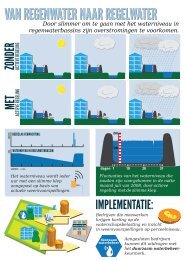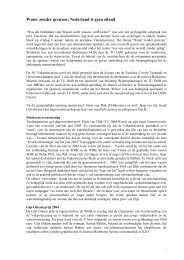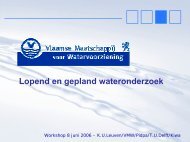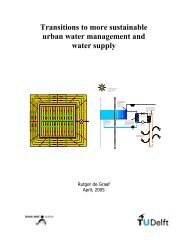Pedestrian route-choice and activity scheduling theory and models
Pedestrian route-choice and activity scheduling theory and models
Pedestrian route-choice and activity scheduling theory and models
You also want an ePaper? Increase the reach of your titles
YUMPU automatically turns print PDFs into web optimized ePapers that Google loves.
Transportation Research Part B 38 (2004) 169–190<br />
www.elsevier.com/locate/trb<br />
<strong>Pedestrian</strong> <strong>route</strong>-<strong>choice</strong> <strong>and</strong> <strong>activity</strong> <strong>scheduling</strong> <strong>theory</strong><br />
<strong>and</strong> <strong>models</strong><br />
S.P. Hoogendoorn * , P.H.L. Bovy<br />
Transportation <strong>and</strong> Traffic Engineering Section, Faculty of Civil Engineering <strong>and</strong> Geosciences,<br />
Delft University of Technology, P.O. Box 5048 - 2600 GA Delft, The Netherl<strong>and</strong>s<br />
Received 29 January 2002; accepted 31 July 2002<br />
Abstract<br />
Among the most interesting <strong>and</strong> challenging theoretical <strong>and</strong> practical problems in describing pedestrians<br />
behavior are <strong>route</strong> <strong>choice</strong> <strong>and</strong> <strong>activity</strong> <strong>scheduling</strong>. Compared to other modes of transport, a characteristic<br />
feature of pedestrian <strong>route</strong> <strong>choice</strong> is that <strong>route</strong>s are continuous trajectories in time <strong>and</strong> space: since a pedestrian<br />
chooses a <strong>route</strong> from an infinite set of alternatives, dedicated theories <strong>and</strong> <strong>models</strong> describing<br />
pedestrian <strong>route</strong> <strong>choice</strong> are required.<br />
This article puts forward a new <strong>theory</strong> of pedestrian behavior under uncertainty based on the concept of<br />
utility maximization. The main behavioral assumption is that pedestrians optimize some predicted pedestrian-specific<br />
utility function, representing a trade-off between the utility gained from performing activities<br />
at a specific location, <strong>and</strong> the predicted cost of walking subject to the physical limitations of the<br />
pedestrians <strong>and</strong> the kinematics of the pedestrian. The uncertainty reflects the r<strong>and</strong>omness of the experienced<br />
traffic conditions.<br />
Based on this normative <strong>theory</strong>, <strong>route</strong> <strong>choice</strong>, <strong>activity</strong> area <strong>choice</strong>, <strong>and</strong> <strong>activity</strong> <strong>scheduling</strong> are simultaneously<br />
optimized using dynamic programming for different traffic conditions <strong>and</strong> uncertainty levels.<br />
Throughout the article, the concepts are illustrated by examples.<br />
Ó 2003 Elsevier Ltd. All rights reserved.<br />
Keywords: <strong>Pedestrian</strong> travel behavior; Route <strong>choice</strong>; Activity <strong>scheduling</strong>; Destination <strong>choice</strong>; Dynamic programming<br />
* Corresponding author. Tel.: +31-15-2785475; fax: +31-15-2783179.<br />
E-mail address: s.hoogendoorn@ct.tudelft.nl (S.P. Hoogendoorn).<br />
0191-2615/$ - see front matter Ó 2003 Elsevier Ltd. All rights reserved.<br />
doi:10.1016/S0191-2615(03)00007-9
170 S.P. Hoogendoorn, P.H.L. Bovy / Transportation Research Part B 38 (2004) 169–190<br />
1. Background<br />
Underst<strong>and</strong>ing pedestrian behavior is essential in the planning <strong>and</strong> the design of airports,<br />
public transport stations, shopping malls, etc., but also in public transit timetable design. Modeling<br />
tools can support infrastructure designers as well as public transport planners to optimize<br />
their plans. Furthermore, the management of pedestrian flows dem<strong>and</strong>s underst<strong>and</strong>ing of both the<br />
collective pedestrian flows as well as the individual pedestrian movements in the flow.<br />
<strong>Pedestrian</strong> traffic <strong>and</strong> vehicular traffic are very different, justifying dedicated <strong>theory</strong> <strong>and</strong> model<br />
development. The differences pertain both to traffic operations, <strong>and</strong> to the travel behavior level.<br />
Motivated by the need for accurate dedicated pedestrian flow <strong>models</strong>, comprehensive <strong>theory</strong> <strong>and</strong><br />
<strong>models</strong> for pedestrian <strong>activity</strong> <strong>scheduling</strong>, <strong>route</strong> determination in the two-dimensional space, <strong>and</strong><br />
walking behavior have been developed. This paper focuses on the behavior at the tactical level.<br />
The walking behavior is discussed elsewhere (Hoogendoorn, 2001).<br />
The article is outlined as follows. Section 2 discusses some empirical facts about pedestrian<br />
<strong>activity</strong> <strong>scheduling</strong> <strong>and</strong> <strong>route</strong> <strong>choice</strong>. Section 3 recalls previous theories <strong>and</strong> <strong>models</strong> describing<br />
pedestrian <strong>route</strong> <strong>choice</strong> behavior. Section 4 outlines the normative <strong>theory</strong>. Sections 5 <strong>and</strong> 6 respectively<br />
present the <strong>route</strong> <strong>choice</strong> <strong>and</strong> <strong>activity</strong> <strong>scheduling</strong> modeling approach. We recall the<br />
walker model from (Hoogendoorn, 2001) in Section 7. Model applications are described in Section<br />
8. Section 9 summarizes the research results <strong>and</strong> discusses future research directions.<br />
2. Empirical facts on pedestrian <strong>scheduling</strong> <strong>and</strong> <strong>route</strong> <strong>choice</strong><br />
In this article, pedestrian <strong>activity</strong> <strong>scheduling</strong> pertains to which, in which order, <strong>and</strong> where pedestrians<br />
perform activities. <strong>Pedestrian</strong> <strong>activity</strong> <strong>scheduling</strong> has not been studied comprehensively<br />
in the past. There are some indications that pedestrians somehow optimize the order in which they<br />
perform their activities, <strong>and</strong> that directness plays an important role (Helbing, 1997).<br />
Hill (1982) has analyzed pedestrian strategies for choosing <strong>and</strong> describing <strong>route</strong>s. He concludes<br />
that, like most walking processes, <strong>route</strong> selection strategies are largely subconscious. Furthermore,<br />
directness is the most common reason for choosing a particular <strong>route</strong>. The <strong>route</strong> directness<br />
pertains not only to the length of the <strong>route</strong>, but also to its complexity (in terms of direction<br />
changes). <strong>Pedestrian</strong>s appear to frequently choose the shortest <strong>route</strong>, albeit they are seldom aware<br />
that they are minimizing distance as a primary strategy in <strong>route</strong> <strong>choice</strong> (Senevarante <strong>and</strong> Morall,<br />
1986; Guy, 1987). Other studies indicate that besides distance, pleasantness is an important <strong>route</strong><br />
attribute together producing a high correlation with the <strong>route</strong> preferences (Bovy <strong>and</strong> Stern, 1990).<br />
Other factors deemed important in <strong>route</strong> <strong>choice</strong> behavior are habit, number of crossings,<br />
pollution <strong>and</strong> noise levels, safety <strong>and</strong> shelter from poor weather conditions, <strong>and</strong> stimulation of the<br />
environment. The extent to which these <strong>route</strong> attributes play a substantial role his <strong>route</strong> <strong>choice</strong><br />
behavior depends to a large extent on trip purpose (Bovy <strong>and</strong> Stern, 1990), e.g. scenery is very<br />
important for recreational trips, but it plays no role for work-related walking trips.<br />
Cheung <strong>and</strong> Lam (1998) study pedestrians choosing between escalators <strong>and</strong> stairways in subway<br />
stations <strong>and</strong> its dependency on the differences in travel times. The authors showed that pedestrians<br />
are more susceptible to delays in the descending direction than in the ascending<br />
direction, <strong>and</strong> are more inclined to use the escalator in the latter case.
S.P. Hoogendoorn, P.H.L. Bovy / Transportation Research Part B 38 (2004) 169–190 171<br />
3. Modeling approaches to pedestrian travel behavior<br />
Queuing <strong>models</strong> (Lovas, 1994) use Markov-chain <strong>models</strong> to described how pedestrians move<br />
from one node of the network (mostly a room) to another. R<strong>and</strong>om waiting times are incurred on<br />
the links, due to queues building up when pedestrian traffic dem<strong>and</strong> is larger than the door capacity.<br />
Queuing <strong>models</strong> have been used mostly to describe pedestrian evacuation behavior from<br />
buildings.<br />
Gipps (1986) <strong>and</strong> Hamacher <strong>and</strong> Tj<strong>and</strong>ra (2001) describe pedestrian <strong>route</strong> <strong>choice</strong> through the<br />
walking facility by determining a finite number of <strong>route</strong>s through the walking infrastructure <strong>and</strong><br />
applying basic discrete <strong>choice</strong> modeling. Similar to the model described in this article, the main<br />
theoretical assumption is that pedestrians make a subjective rational <strong>choice</strong> between alternatives.<br />
Contrary to the model described in this article, the number of <strong>choice</strong> options is finite. Verl<strong>and</strong>er<br />
(1997) estimates discrete <strong>choice</strong> <strong>models</strong> using household-based diary data. Teklenburg et al. (1993)<br />
use a Space Syntax model, which is calibrated using pedestrian flow data.<br />
Notwithst<strong>and</strong>ing the practicality of assuming only a limited number of <strong>route</strong> alternatives, in<br />
real life pedestrians can choose between an infinite (<strong>and</strong> in fact, non-countable) number of <strong>route</strong>s.<br />
Using potential functions, Hughes (2002) accounts for this aspect, by describing the optimal<br />
walking direction to the destination (in terms of travel time) as a function of the current location x<br />
of the pedestrian. However, the approach prohibits including general <strong>route</strong> attributes, such as<br />
walking distance or stimulation of the environment, as well as uncertainty in the traffic conditions<br />
expected by the pedestrians. The research described in this article has succeeded in remedying<br />
these issues, while at the same time establishing a solid theoretical basis for pedestrian <strong>route</strong><strong>choice</strong><br />
<strong>and</strong> <strong>activity</strong> <strong>scheduling</strong>.<br />
4. Normative pedestrian behavior <strong>theory</strong><br />
The main behavioral assumption here, is that all actions of the pedestrian, let it be performing<br />
an <strong>activity</strong> or walking along a certain <strong>route</strong>, will provide utility (or equivalently, induce cost) to<br />
him. The pedestrian will predict <strong>and</strong> optimize this expected utility, taking into account the uncertainty<br />
in the expected traffic conditions (similar to microeconomic consumer <strong>theory</strong>). It is well<br />
known that normative <strong>choice</strong> <strong>theory</strong> will not fully cover real-life human <strong>choice</strong> behavior. It does<br />
however provide a very convenient framework for modeling human decision making (Van Berkum<br />
<strong>and</strong> Van Der Mede, 1993). Moreover, several empirical studies have shown the applicability<br />
of utility-based approaches to pedestrian <strong>route</strong> <strong>choice</strong> (Hill, 1982; Bovy <strong>and</strong> Stern, 1990). Hence,<br />
its use in pedestrian behavior <strong>theory</strong> is justified.<br />
The <strong>theory</strong> presented here differs from discrete <strong>choice</strong> <strong>theory</strong> in a number of ways. First <strong>and</strong><br />
foremost, an infinite number of alternative <strong>route</strong>s is considered. Secondly, the r<strong>and</strong>omness in the<br />
<strong>theory</strong> pertains to the uncertainty in the <strong>route</strong> that can be realised. In stochastic discrete <strong>choice</strong><br />
<strong>theory</strong>, the r<strong>and</strong>omness reflects both the fact that people do not always make the same decisions<br />
under the same circumstances <strong>and</strong> the analystÕs lack of more precise knowledge about individualsÕ<br />
decision processes. Furthermore, discrete <strong>choice</strong> <strong>models</strong> are often used to describe the differences<br />
in observed <strong>choice</strong>s made in a sample of individuals. The <strong>theory</strong> presented here is designed to<br />
describe <strong>choice</strong> behavior of individuals, <strong>and</strong> is there not directly representative for groups of
172 S.P. Hoogendoorn, P.H.L. Bovy / Transportation Research Part B 38 (2004) 169–190<br />
individuals. Nevertheless, the continuous <strong>theory</strong> is easily extended to include for instance taste<br />
variation.<br />
4.1. <strong>Pedestrian</strong> behavioral levels<br />
In out approach we distinguish <strong>choice</strong>s at the following three levels:<br />
1. Departure time <strong>choice</strong>, <strong>and</strong> <strong>activity</strong> pattern <strong>choice</strong> (strategic level);<br />
2. Activity <strong>scheduling</strong>, <strong>activity</strong> area <strong>choice</strong>, <strong>and</strong> <strong>route</strong>-<strong>choice</strong> to reach <strong>activity</strong> areas (tactical level);<br />
3. Walking behavior (operational level).<br />
In this hierarchy, expected utilities at lower levels influence <strong>choice</strong>s at higher levels. Choices at<br />
higher levels condition <strong>choice</strong> sets at lower levels. This article focuses on pedestrian behavior at<br />
the tactical level. The events <strong>and</strong> decisions causing the pedestrian to arrive at the walking facility<br />
are not considered; pedestrian arrival patterns, distinguishing groups of pedestrians having similar<br />
characteristics (<strong>activity</strong> sets, travel purpose, demographic characteristics, etc.) are assumed known<br />
a priori. With respect to the operational level, it is hypothesized that pedestrians adhere to their<br />
planned <strong>route</strong> (determined at the tactical level) as much as possible. In addition, walking is affected<br />
by interactions with other pedestrians or obstacles. For details, we refer to (Hoogendoorn,<br />
2001).<br />
The tactical level behavior is influenced by both external factors (e.g. presence of obstacles,<br />
stimulation of the environment), <strong>and</strong> internal (or personal) factors (e.g. time–pressure, attitudes of<br />
the pedestrian). Together with the expected traffic conditions (congestion, average speeds), the<br />
decisions at the tactical level serve as input for pedestrianÕs walking behavior. In turn, the traffic<br />
conditions resulting from the pedestrian traffic dem<strong>and</strong>s <strong>and</strong> the collective walking behavior will<br />
affect the expected traffic conditions <strong>and</strong> thus the behavior at the tactical level.<br />
4.2. Tactical level decision variables<br />
Before we present the problem formulation, let us introduce the key decision variables for the<br />
pedestrian behavior at the tactical level<br />
1. The <strong>activity</strong> schedule S ¼fig, which is an ordered set describing which activities i 2 R are performed<br />
<strong>and</strong> in which order.<br />
2. The velocity trajectory vðÞ yielding the <strong>route</strong> xðÞ through the facility.<br />
3. The <strong>activity</strong> times T i at which activities i 2 S are performed, such that xðT i Þ2A ij for some j,<br />
where A ij denote the <strong>activity</strong> areas where <strong>activity</strong> i can be performed.<br />
A pedestrian arriving at the walking facility X R 2 aims to perform (a type of) activities from<br />
the subjective <strong>activity</strong> <strong>choice</strong> set R, which consists of possible activities to perform in the facility,<br />
e.g. ‘‘buy a newspaper’’, ‘‘buy a train ticket’’, ‘‘wait at the train platform’’, or ‘‘access the train’’.<br />
The activities are generic, <strong>and</strong> reflect the purposes of the pedestrians in the facility.<br />
The pedestrian chooses activities from the subjective <strong>activity</strong> <strong>choice</strong> set R, yielding the <strong>activity</strong><br />
schedule S ¼fig. S describes which activities from R are performed <strong>and</strong> in which order. The
S.P. Hoogendoorn, P.H.L. Bovy / Transportation Research Part B 38 (2004) 169–190 173<br />
pedestrian may have some freedom to choose where <strong>activity</strong> i from S is performed. This is<br />
modeled by considering different <strong>activity</strong> areas A ij X with j ¼ 1; ...; J i , where <strong>activity</strong> i can be<br />
performed. For example, a traveler can ‘‘buy a newspaper’’ at different ticket machines or ticket<br />
offices.<br />
Terminal time T i for <strong>activity</strong> i denotes the instant at which <strong>activity</strong> i is completed. That is, the<br />
difference T i T i 1 equals the expected walking time <strong>and</strong> the time needed to perform <strong>activity</strong> i.<br />
Together with the <strong>route</strong> xðÞ through the facility, the terminal time determines the <strong>activity</strong> area A ij<br />
chosen by the pedestrian, i.e. xðT i Þ2A ij (assuming that the pedestrian will not move while performing<br />
the <strong>activity</strong>). The <strong>route</strong> xðÞ is a continuous function, uniquely determined by the velocity<br />
path vðÞ<br />
xðÞ :¼ fxðsÞ 2Xjt 0 6 s 6 t 1 s:t: _xðsÞ ¼vðsÞ <strong>and</strong> xðt 0 Þ¼x 0 g ð1Þ<br />
4.3. Subjective utility optimization at the tactical level<br />
We hypothesize that at the tactical level, a pedestrian makes a simultaneous decision at time t 0<br />
minimizing the expected disutility or cost C. This decision will cover all decision variables described<br />
in the previous section (<strong>activity</strong> patterns S, terminal times T i , <strong>and</strong> the velocity path vðÞ).<br />
The expected disutility C ¼ CðS; fT i g i2S<br />
; vðÞjt 0 ; x 0 Þ of the combined <strong>choice</strong> of a pedestrian entering<br />
the walking facility at instant t 0 at location x 0 stems from performing specific activities at certain<br />
<strong>activity</strong> areas, the order in which the activities are performed, <strong>and</strong> the expected cost of walking<br />
between the <strong>activity</strong> areas. We assume that the total disutility can be written as follows<br />
CðS; fT i g i2S<br />
; vðÞjt 0 ; x 0 Þ :¼ X i2S<br />
C i ðT i ; vðÞjT i 1 ; xðT i 1 ÞÞ þ wðSÞ ð2Þ<br />
where C i denotes the combined cost of walking from the location xðT i 1 Þ2A i 1j to xðT i Þ2A ij<br />
where <strong>activity</strong> i is performed, <strong>and</strong> the cost (or utility U ij ) of performing <strong>activity</strong> i at <strong>activity</strong> area<br />
A ij ; w denotes the cost of the <strong>activity</strong> <strong>scheduling</strong> (e.g. due to the specific order of activities). In the<br />
remainder, the components C i are specified. Subjective utility optimization then yields that the<br />
pedestrian makes the following combined <strong>choice</strong> at the tactical level<br />
ðS ; fT i g i2S ; v ðÞÞ ¼ arg minCðS; fT i g i2S<br />
; vðÞjt 0 ; x 0 Þ<br />
ð3Þ<br />
Activity i may be performed at multiple <strong>activity</strong> areas A ij , yielding different utilities U ij . These<br />
differences reflect personal preferences for using a certain area (e.g. describing that pedestrians<br />
expect different waiting times at different ticket offices). Some activities are discretionary, others<br />
are m<strong>and</strong>atory, which is described by high penalties / i experienced when <strong>activity</strong> i is not performed.<br />
The order in which activities are performed generally depends on the directness (Helbing,<br />
1997) <strong>and</strong> results from the simultaneous <strong>choice</strong>s made at the tactical level. Directness is reflected<br />
by the cost stemming from the trajectory xðÞ; wðSÞ is generally only used describe that the <strong>activity</strong><br />
order is restricted, implying that some activities can be performed only once others are completed.<br />
Although pedestrian <strong>route</strong> <strong>choice</strong> is mostly subconscious, assuming that <strong>route</strong> <strong>choice</strong> strategies<br />
are applicable to predict pedestrian <strong>choice</strong> behavior is fruitful from a modeling viewpoint (Hill,<br />
1982). We therefore assume that the pedestrian <strong>route</strong> <strong>choice</strong> is based on utility optimization. The<br />
disutility C i of a <strong>route</strong> will depend among other things on (Chiolek, 1978; Gipps, 1986):
174 S.P. Hoogendoorn, P.H.L. Bovy / Transportation Research Part B 38 (2004) 169–190<br />
1. Distance or travel time between origin <strong>and</strong> destination.<br />
2. Proximity of obstacles or other physical obstructions; closeness to walls.<br />
3. Number of sharp turns <strong>and</strong> rapid directional changes (<strong>route</strong> directness).<br />
4. Expected number of interactions with other pedestrians (level-of-service).<br />
5. Stimulation of environment, <strong>and</strong> attractiveness (e.g. ambience conditions, shopping windows,<br />
shelter in case of poor weather conditions).<br />
Empirical studies (Bovy <strong>and</strong> Stern, 1990; Guy, 1987; Senevarante <strong>and</strong> Morall, 1986) have<br />
shown that these factors are not mutually consistent, while their importance in <strong>route</strong> <strong>choice</strong> will<br />
vary between different (homogeneous) groups of pedestrians.<br />
4.4. Prevailing traffic conditions <strong>and</strong> dynamic pedestrian assignment<br />
One important aspect in pedestrian <strong>activity</strong> <strong>scheduling</strong> <strong>and</strong> <strong>route</strong> <strong>choice</strong> is the inclusion of<br />
prevailing or future traffic conditions into the decision-making at the tactical level. We assume<br />
that pedestrians have information (visual information, experience) regarding prevailing <strong>and</strong> future<br />
conditions <strong>and</strong> choose their planned schedule <strong>and</strong> <strong>route</strong> accordingly. If we assume that only the<br />
current conditions are included, the <strong>route</strong> costs can simply be computed given prevailing conditions.<br />
It is likely that the pedestrian will reconsider his <strong>choice</strong>s made at several times t during his<br />
stay in the walking facility, thereby considering the observed in the current traffic conditions.<br />
Assuming that the pedestrians have complete information concerning future flow conditions,<br />
we need to explicitly consider the consistency between <strong>activity</strong> <strong>scheduling</strong>/<strong>route</strong> <strong>choice</strong> <strong>and</strong> flow<br />
operations. While the behavior at the tactical level is dependent on the (future) flow operations,<br />
these will in turn depend on the <strong>activity</strong> <strong>scheduling</strong> <strong>and</strong> pedestrian <strong>route</strong>-<strong>choice</strong>. We then need to<br />
solve a user-optimal <strong>choice</strong> equilibrium problem.<br />
4.5. Operationalization of pedestrian behavior <strong>theory</strong><br />
In the remainder, we will operationalize the outlined <strong>theory</strong>, proposing <strong>models</strong> describing<br />
pedestrian behavior at the tactical level. We derive <strong>models</strong> by applying dynamic programming<br />
<strong>theory</strong>. In Section 5, <strong>models</strong> are proposed for pedestrian <strong>route</strong> <strong>choice</strong> under uncertainty in<br />
continuous time <strong>and</strong> space for a single <strong>activity</strong> with multiple <strong>activity</strong> areas A ij . Subsequently, we<br />
will propose <strong>models</strong> to describe how pedestrians determine the subjective optimal <strong>activity</strong><br />
schedule (Section 6).<br />
5. Optimal subjective <strong>route</strong>-<strong>choice</strong> under uncertainty<br />
This section considers the combined <strong>route</strong>-<strong>choice</strong> <strong>and</strong> <strong>activity</strong> area <strong>choice</strong> of a pedestrian aiming<br />
to perform a given <strong>activity</strong> i at either of the <strong>activity</strong> areas A ij , with j ¼ 1; ...; J i , where <strong>activity</strong> i<br />
can be performed. We assume that in simultaneously choosing the destination area <strong>and</strong> the <strong>route</strong>,<br />
the pedestrian will minimize the subjective expected disutility. In subjective utility <strong>theory</strong>, perceived<br />
disutility is generally assumed to be the weighted sum of different <strong>route</strong> attributes, such as<br />
(expected) travel time, travel time variance, distance traveled, safety, comfort, etc. <strong>Pedestrian</strong>s will
S.P. Hoogendoorn, P.H.L. Bovy / Transportation Research Part B 38 (2004) 169–190 175<br />
often have to divert from their planned <strong>route</strong>, e.g. when interacting with another pedestrian, thus<br />
having to reconsider a new <strong>route</strong>. The <strong>theory</strong> should provide a framework in which the pedestrianÕs<br />
flexible adaptation to other <strong>route</strong>s is included. This is solved mathematically by treating the<br />
<strong>route</strong> <strong>and</strong> <strong>activity</strong> area <strong>choice</strong> problem simultaneously for all locations x <strong>and</strong> instants t, adopting<br />
the so-called expected minimum perceived disutility function W ðt; xÞ in continuous time <strong>and</strong> space.<br />
5.1. <strong>Pedestrian</strong> kinematics<br />
To apply the approach, consider the location x (the state) <strong>and</strong> the velocity v (the control) ofa<br />
pedestrian. To describe the <strong>route</strong> <strong>choice</strong> behavior, it is hypothesized that the pedestrian uses an<br />
internal model to estimate <strong>and</strong> predict the <strong>route</strong> costs. To this end, he will determine his current<br />
position xðtÞ at instant t, reflected by ^x, <strong>and</strong> predict his future positions xðsÞ for s > t using the<br />
internal state prediction model:<br />
dx ¼ vdt þ rdw subject to xðtÞ ¼^x ð4Þ<br />
Here v ¼ vðsÞ denotes velocity (i.e. speed <strong>and</strong> direction) of the pedestrian for s > t. In this formulation,<br />
w denotes a st<strong>and</strong>ard Wiener process, meaning that for very small time periods ½t; t þ hÞ,<br />
the increase wðt þ hÞ wðtÞ is a Nð0; hI m Þ-distributed r<strong>and</strong>om variable, where I m denotes the m <br />
m m identity matrix; r ¼ rðx; vÞ is a 2 m matrix, reflecting the way in which the white noise<br />
vector w affects the location; rðwðt þ hÞ wðtÞÞ is Nð0; hrr 0 Þ-distributed. The white noise term<br />
reflects the uncertainty in the expected traffic conditions <strong>and</strong> the resulting effects on the subjectÕs<br />
kinematics. The uncertainty reflects among other things lack of experience, observability <strong>and</strong><br />
r<strong>and</strong>omness of future conditions.<br />
The speed jjvjj of the pedestrians is restricted by their physical limitations, <strong>and</strong> by the presence<br />
of other pedestrians in the flow. This is why the following restrictions are applied to the velocity v<br />
v 2 V a ðt; xÞ where V a ðt; xÞ ¼fv such that kvk 6 v 0 ðt; xÞg R 2 ð5Þ<br />
where V a denotes the set of admissible velocities. The dependence on t <strong>and</strong> x is used to describe<br />
that the maximum speed may change due to changing flow conditions, as well as differences in<br />
maximum speeds between different parts of the walking infrastructure. In illustration, the maximum<br />
speed on flat terrain will be higher than on a stairway or an escalator. The pedestrian p<br />
specific maximum speed also depends on the characteristics of p (age, gender, trip-purpose, luggage,<br />
etc.).<br />
5.2. Generalized walking cost <strong>and</strong> <strong>activity</strong> utility<br />
Let ½t; t 1 Þ denote the pedestrianÕs planning period, where t <strong>and</strong> t 1 respectively denote the current<br />
time <strong>and</strong> the terminal time (planning horizon); let T a denote the time of first arrival at either <strong>activity</strong><br />
area A ij , <strong>and</strong> let T i ¼ minðt 1 ; T a Þ. Consider the velocity (or control) path v ½t;Ti Þ. In applying this<br />
ÔcontrolÕ, the pedestrian predicts his location using the internal model (4). The predicted location<br />
xðsÞ is a stochastic variable. We hypothesize that given an arbitrary control path v ½t;Ti Þ <strong>and</strong> initial<br />
position xðtÞ ¼^x, the pedestrian will determine the expected disutility or expected cost C i of applying<br />
the intended velocity v ½t;Ti Þ, according to the following cost definition
176 S.P. Hoogendoorn, P.H.L. Bovy / Transportation Research Part B 38 (2004) 169–190<br />
Z Ti<br />
<br />
C i ðT i ; v ½t;Ti ÞjT i 1 ; xðT i 1 ÞÞ :¼ E Lðs; xðsÞ; vðsÞÞds þ /ðT i ; xðT i ÞÞ<br />
t<br />
s.t. Eq. (4), where L <strong>and</strong> / denote the so-called running cost <strong>and</strong> the terminal cost respectively.<br />
The running cost Lðs; xðsÞ; vðsÞÞ reflects the costs that are incurred during a very small time<br />
period [s; s þ ds), given that the subject is located at xðsÞ <strong>and</strong> is ÔapplyingÕ velocity vðsÞ to change<br />
his position. The terminal cost /ðT i ; xðT i ÞÞ reflect the cost due to ending up at position xðT i Þ at the<br />
terminal time T i . These costs typically reflect the penalty that may be incurred when the subject<br />
does not arrive at the destination areas A ij in time. Note that since the <strong>route</strong> costs are described by<br />
means of an integral (6), the <strong>theory</strong> assumes that the <strong>route</strong> costs are additive (i.e. the total <strong>route</strong><br />
cost can be described by the sum of the costs of its constituent sub<strong>route</strong>s).<br />
5.3. Specification of the terminal cost<br />
By definition, the terminal time T i either equals the final time t 1 of the planning period or the<br />
first time T a the pedestrian arrives at either of the <strong>activity</strong> areas A ij . As a result, the terminal costs<br />
/ are described on a region in ½t; t 1 ŠX ; in mathematical terms:<br />
<br />
/ðT i ; xðT i ÞÞ ¼<br />
U ij ðT i Þ xðT i Þ2A ij T i < t 1<br />
/ i xðT i Þ 62 [ j A ij T i ¼ t 1<br />
The terminal cost / thus reflects the penalty / i for not having arrived at any of the <strong>activity</strong> areas<br />
A ij in time, i.e. before the end t 1 of the planning period, <strong>and</strong> the area specific utility U ij of performing<br />
<strong>activity</strong> i at A ij . Note that to include preferred arrival times the utility U ij depends on the<br />
terminal time T i . Also note that by including multiple <strong>activity</strong> areas in the terminal costs, the <strong>route</strong><br />
<strong>choice</strong> <strong>and</strong> <strong>activity</strong> area <strong>choice</strong> problem in performing a certain i can be solved jointly.<br />
5.4. Specification of the running costs<br />
The running cost L reflects the different cost aspects relating to the <strong>route</strong> attributes considered<br />
by p. For the sake of simplicity, we assume that the running cost is linear-in-parameters, i.e.<br />
Lðt; x; vÞ ¼ X c k L k ðt; x; vÞ<br />
ð8Þ<br />
k<br />
where L k denote the contribution of the different <strong>route</strong> attributes k, <strong>and</strong> c k denote the relative<br />
weights (importance of the attributes). However, linearity is not required for application of the<br />
approach described in the remainder of this article. Note that not all weights can be uniquely determined<br />
from real-life observed behavior, since only the relative importance of the weights is<br />
relevant. The parameters c k will be different for different homogeneous groups, e.g. groups having<br />
different travel purposes. Alternatively, the parameters can reflect differences amongst pedestrians<br />
according to their age, gender, physical health, etc. The different cost factors L k are described in<br />
the ensuing sections.<br />
ð6Þ<br />
ð7Þ<br />
5.4.1. Expected travel time<br />
Expected travel time is included in the expected <strong>route</strong> cost (6) by defining L 1 as follows<br />
L 1 ðt; x; vÞ ¼1<br />
ð9Þ
Substitution of running cost (9) yields the following contribution to the <strong>route</strong> cost (6)<br />
Z Ti<br />
Z Ti<br />
<br />
E L 1 ðs; xðsÞ; vðsÞÞds ¼ E c 1 ds ¼ c 1 E½T i tŠ ð10Þ<br />
t<br />
S.P. Hoogendoorn, P.H.L. Bovy / Transportation Research Part B 38 (2004) 169–190 177<br />
t<br />
Eq. (10) shows that the contribution of the running cost factor (9) is indeed equal to the expected<br />
travel time T i t, multiplied by the weight c 1 . This weight factor c 1 expresses time–pressure, which<br />
in turn depends on for instance the trip purpose.<br />
5.4.2. Discomfort due to walking too close to obstacles <strong>and</strong> walls<br />
Obstacles are described by areas O m X, for m ¼ 1; ...; M. For any obstacle m, we assume that<br />
the running cost component L 2 is given by a monotonically decreasing function g of the distance<br />
dðx; O m Þ between the location x of the pedestrian <strong>and</strong> the obstacle, i.e.<br />
L 2 ðt; x; vÞ ¼g m ðdðO m ; xÞÞ ¼ a m expð dðO m ; xÞ=b m Þ ð11Þ<br />
The distance is defined by the minimum distance between the pedestrian location x <strong>and</strong> obstacle m<br />
dðx; O m Þ¼min<br />
y2O m<br />
fjjx yjjg ð12Þ<br />
where jjzjj is the Euclidean length of a vector z. Eq. (11) is based on the specification of the repellent<br />
force term of obstacles proposed by Helbing (1997). The parameters a m > 0 <strong>and</strong> b m > 0 are<br />
scaling parameters, describing the region of influence of obstacle m. Both a m <strong>and</strong> b m are dependent<br />
on the type of obstacle that is considered, e.g. they are different for building faces with <strong>and</strong><br />
without a window, regular walls, trees, newsst<strong>and</strong>s, etc. (HCM, 2000).<br />
5.4.3. Walking at a certain speed (planned walking speed)<br />
To describe that the planned walking speed jjvjj is a trade-off between the time remaining to get<br />
to the <strong>activity</strong> area in time <strong>and</strong> the energy use due to walking at a particular speed, we assume that<br />
this energy consumption is a quadratic function of the pedestrian speed<br />
L 3 ðt; x; vÞ ¼ 1 2 jjvjj2 ¼ 1 2 v0 v<br />
ð13Þ<br />
It is interesting to see that in practice, energy consumption, walking speed, <strong>and</strong> time–pressure<br />
appear to be closely connected: Weidmann (1993) shows that the Ôoptimal energy levelÕ (e.g.<br />
minimal energy consumption per kilometer) is attained at walking speeds of 1.39 m/s, which is<br />
close to observed average speeds of 1.34 m/s.<br />
5.4.4. Expected number of pedestrian interactions (discomfort due to crowding) <strong>and</strong> level-of-service<br />
In including the cost of the expected pedestrian interactions, we consider the function f ¼ fðt; xÞ,<br />
describing the expected number of interactions with other pedestrians at ðt; xÞ. Note that for<br />
pedestrian flow operations, the frequency <strong>and</strong> the severity of interactions (or rather, physical<br />
contact) relates directly to the definition of the level-of-service (HCM, 2000). In the remainder, it is<br />
assumed that fðt; xÞ is some (non-linear) function of the density kðt; xÞ<br />
L 4 ðt; x; vÞ ¼fðkðt; xÞÞ ð14Þ
178 S.P. Hoogendoorn, P.H.L. Bovy / Transportation Research Part B 38 (2004) 169–190<br />
We can argue that, depending on trip-purpose, age, gender, etc. pedestrians may be inclined to<br />
walk in areas where there are at least some pedestrians. In this case, small density values may have<br />
an attracting effect on pedestrians <strong>route</strong> <strong>choice</strong> behavior, yielding that fðkÞ < 0 for some k < k cr .<br />
5.4.5. Stimulation of the environment<br />
Finally, we consider the stimulating effects of the environment. This can be described relatively<br />
easy by considering the benefit cðt; xÞ 6 0 of walking at a certain location x at instant t. Note that<br />
the benefit has a negative sign (negative cost). We have<br />
L 5 ðt; x; vÞ ¼cðt; xÞ<br />
In substituting the contributions (9)–(15) into the running cost (8), we get<br />
X<br />
Lðt; x; vÞ ¼c 1 þ c 2 a m e dðx;O mÞ=b m<br />
þ 1 2 c 3v 0 v þ c 4 fðt; xÞþc 5 cðt; xÞ<br />
m<br />
ð15Þ<br />
ð16Þ<br />
Note that generally the weights c k as well as the weights a m cannot be determined uniquely from<br />
data, since only the ratio between the weights are determinant for pedestrian behavior. Without<br />
loss of generality, we can set c 1 ¼ 1.<br />
The approach is easily adapted when considering a heterogeneous population with taste-variation<br />
<strong>and</strong> differences in the physical abilities. In fact, these differences are the main reasons for<br />
including the different cost factors: empirical research has indicated large differences in how<br />
different types of pedestrians value <strong>route</strong> attributes (Bovy <strong>and</strong> Stern, 1990; Hill, 1982; Senevarante<br />
<strong>and</strong> Morall, 1986; Guy, 1987). The pedestrian population is stratified into homogeneous groups,<br />
<strong>and</strong> <strong>route</strong>-<strong>choice</strong> <strong>and</strong> <strong>activity</strong> <strong>scheduling</strong> is solved for each group. The characteristics of each<br />
homogeneous group is characterized by the utilities U ij gained when performing <strong>activity</strong> i at A ij ,<br />
the weights c k , <strong>and</strong> the maximum walking speed v 0 ðt; xÞ. For instance, when travel time is the<br />
dominant factor (e.g. for commuting pedestrians), c 1 will be relatively large compared to c 2 , c 4 <strong>and</strong><br />
c 5 ; when shopping, stimulation of the environment will be a relatively important attribute, which<br />
is expressed by c 5 . Furthermore, the weights c k also depend on the situation: in case of an<br />
emergency, travel time (or distance) will be the dominantly important attribute. In the latter case<br />
however, the applicability of utility optimization approaches may be limited, depending on the<br />
evacuation situation.<br />
5.5. Route <strong>choice</strong> <strong>and</strong> <strong>activity</strong> area <strong>choice</strong> in continuous space<br />
Let us now formulate the combined <strong>route</strong>-<strong>choice</strong> <strong>and</strong> <strong>activity</strong> area (destination) <strong>choice</strong> problem.<br />
Eq. (6) shows that the expected (predicted) subjective cost C is a function of initial instant t,<br />
location xðtÞ ¼^x, <strong>and</strong> velocity path v ½t;Ti Þ.<br />
5.5.1. Modeling principle <strong>and</strong> problem formulation<br />
The subjective utility optimization paradigm implies that the pedestrian will choose the velocities<br />
v ½t;Ti Þ yielding the predicted <strong>route</strong> <strong>and</strong> used <strong>activity</strong> area that minimize the subjective expected<br />
cost (6) subject to the internal prediction model (4). The subjective utility optimization<br />
paradigm thus that the pedestrian determines the optimal velocity v ½t;T i Þ satisfying
S.P. Hoogendoorn, P.H.L. Bovy / Transportation Research Part B 38 (2004) 169–190 179<br />
<br />
<br />
Z Ti<br />
<br />
v ½t;T i Þ ¼ arg minC i t; ^x; v ½t;Ti Þ; fA ij g ¼ arg minE Lðs; xðsÞ; vðsÞÞds þ /ðT i ; xðT i ÞÞ ð17Þ<br />
where L <strong>and</strong> / are given by Eqs. (8) <strong>and</strong> (7) respectively. To solve the path <strong>choice</strong> problem, let us<br />
define the so-called expected minimum perceived disutility function W ðt; ^xÞ (often referred to as the<br />
value function in optimal control <strong>theory</strong>) by the expected value of the costs upon applying the<br />
optimal velocity v ½t;T i Þ<br />
Z Ti<br />
<br />
W ðt; ^xÞ :¼ E Lðs; x ðsÞ; v ðsÞÞ þ /ðT i ; x ðT i ÞÞ<br />
ð18Þ<br />
subject to<br />
t<br />
dx ¼ v dt þ rðx ; v Þdw subject to x ðtÞ ¼^x<br />
To derive the dynamic programming equation, consider the period [t; t þ h). According to BellmanÕs<br />
optimization principle (Bellman, 1957), we have<br />
Z tþh<br />
<br />
W ðt; ^xÞ ¼E Lðs; x ðsÞ; v ðsÞÞ þ W ðt þ h; x ðt þ hÞÞ<br />
ð20Þ<br />
t<br />
Eq. (20) describes that the expected minimal cost of walking from ðt; ^xÞ to A ij equals the minimal<br />
expected cost of both walking from ðt; ^xÞ to ðt þ h; x ðt þ hÞÞ <strong>and</strong> walking from ðt þ h; x ðt þ hÞÞ to<br />
A ij . For small h, the following approximation is valid<br />
Z tþh<br />
<br />
E Lðs; xðsÞ; vðsÞÞ ¼ Lðt; xðtÞ; vðtÞÞh þ Oðh 2 Þ<br />
ð21Þ<br />
t<br />
The r<strong>and</strong>om variate xðt þ hÞ describing the predicted location at instant t þ h subject to Eq. (4)<br />
can be exp<strong>and</strong>ed using a Taylor series<br />
p<br />
xðt þ hÞ ¼^x þ hvðtÞþr<br />
ffiffiffi<br />
h w þ Oðh 3=2 Þ<br />
ð22Þ<br />
where rh 1=2 w is a Nð0; hrr 0 Þ distributed r<strong>and</strong>om variate. We can rewrite the expected value of the<br />
second term of the right-h<strong>and</strong>-side of Eq. (20)<br />
E½W ðt þ h; xðt þ hÞÞŠ ¼ W ðt þ h; ^x þ hvÞþ h X<br />
H ij ðx; vÞ o2 W ðt; ^xÞ<br />
þ Oðh 3=2 Þ ð23Þ<br />
2<br />
ox i ox j<br />
where Hðx; vÞ :¼ rðx; vÞr 0 ðx; vÞ. Substitution of Eqs. (21) <strong>and</strong> (23) into Eq. (20), using the appropriate<br />
Taylor series expansions, <strong>and</strong> taking the limit h ! 0 yields the so-called Hamilton–<br />
Jacobi–Bellman (HJB) or dynamic programming equation for decision making in continuous time<br />
<strong>and</strong> space under uncertainty<br />
o<br />
W ðt; xÞ ¼Hðt; x; rW ; DW Þ<br />
ot ð24Þ<br />
with terminal conditions<br />
W ðt 1 ; xÞ ¼/ i<br />
ð25Þ<br />
ij<br />
t<br />
ð19Þ
180 S.P. Hoogendoorn, P.H.L. Bovy / Transportation Research Part B 38 (2004) 169–190<br />
<strong>and</strong> boundary conditions<br />
W ðT i ; xÞ ¼ U ij ðT i Þ for x 2 A ij <strong>and</strong> T i < t 1 ð26Þ<br />
The Hamilton function H is an auxiliary function, defined by<br />
(<br />
Hðt; x; rW ; DW Þ :¼ min Lðt; x; vÞ þ X )<br />
oW<br />
v i þ 1 X<br />
H ij ðx; vÞ o2 W<br />
ð27Þ<br />
v2V a ðt;xÞ<br />
ox<br />
i i 2<br />
ox<br />
ij<br />
i ox j<br />
Eq. (24) is the dynamic programming equation for the continuous stochastic dynamic user-optimal<br />
(CSDUO) <strong>route</strong> <strong>choice</strong> <strong>and</strong> <strong>activity</strong> area <strong>choice</strong> problem. Using terminal conditions (25) at t 1 , the<br />
HJB equation can be solved backwards in time, subject to boundary conditions (26). The solution<br />
W ðt; xÞ describes the minimum expected cost to the either of the <strong>activity</strong> areas for a pedestrian<br />
located at x at instant t. From W ðt; xÞ, the optimal <strong>route</strong> can be determined easily, as is shown in<br />
the following section.<br />
5.5.2. Optimal speed <strong>and</strong> direction<br />
The optimal velocity v at time t satisfies<br />
(<br />
v ðt; xÞ ¼arg min Lðt; x; vÞ þ X )<br />
oW<br />
v i þ 1 X<br />
H ij ðx; vÞ o2 W<br />
ð28Þ<br />
ox<br />
i i 2<br />
ox<br />
ij<br />
i ox j<br />
subject to v ðt; xÞ 2V a ðt; xÞ. Assume that the level of uncertainty does not explicitly depend on the<br />
velocity, i.e. H ij ðx; vÞ ¼H ij ðxÞ. It can then be shown that for the running cost definition (16), we find<br />
v ðt; xÞ ¼V ðt; xÞe ðt; xÞ<br />
ð29Þ<br />
where the optimal speed V <strong>and</strong> optimal direction e are defined by<br />
V ðt; xÞ :¼ minfc 1<br />
3 krW k; v 0ðt; xÞg <strong>and</strong> e ðt; xÞ :¼ rW =krW k ð30Þ<br />
The partial derivatives rW are the marginal cost of x: ifx changes by a small amount dx, the<br />
change in the total minimal cost W ðt; xÞ equals rW 0 dx. Eq. (30) shows how the optimal direction<br />
e ðt; xÞ points in the direction in which the optimal cost decreases most rapidly. Upon walking into<br />
this direction, Eq. (30) shows that the optimum speed V ðt; xÞ depends on the rate jjrW ðt; xÞjj at<br />
which the minimum cost W ðt; xÞ function decreases in the optimal direction e , the relative cost c 3<br />
of walking at high speeds, <strong>and</strong> the maximum admissible speed v 0 ðt; xÞ at position x <strong>and</strong> time t: when<br />
the expected minimum perceived disutility function W ðt; xÞ decreases very rapidly, the pedestrian<br />
will walk at the maximum speed v 0 ðt; xÞ. When either W ðt; xÞ decreases very slowly in the optimal<br />
walking direction, pedestrians tend to walk at a speed lower than v 0 ðt; xÞ. This may be the case<br />
when the time–pressure is low: in line with empirical observations, where walking speed for pedestrians<br />
having higher time–pressure (e.g. commuters) are farther from the Ôenergy consumptionoptimalÕ<br />
walking speeds than in case the time–pressure is lower (e.g. shopping pedestrians).<br />
5.5.3. Numerical solution approach<br />
The dynamic programming Eq. (24) can be solved by discretizing the area X into small d d-<br />
cells, <strong>and</strong> considering approximate solutions on this lattice at fixed time instants t k ¼ hk (i.e. d is<br />
the spatial step size, <strong>and</strong> h is the temporal step size). We can show that the resulting problem is a
S.P. Hoogendoorn, P.H.L. Bovy / Transportation Research Part B 38 (2004) 169–190 181<br />
Markov diffusion process in two dimensions with nearest-neighbor transitions that are determined<br />
by the stochastic differential Eq. (4) (Fleming <strong>and</strong> Soner, 1993). Solving this (discrete) stochastic<br />
dynamic programming problem is related to solving Eq. (24) by replacing the partial derivatives<br />
with the appropriate finite differences. Let u i denote the unit vector in the ith dimension (i ¼ 1; 2).<br />
The forward finite difference D þ x i<br />
W <strong>and</strong> backward finite difference D xi<br />
W are defined by<br />
D x i<br />
W :¼ d 1 ½W ðt; x du i Þ W ðt; xÞŠ for i ¼ 1; 2 ð31Þ<br />
For the second-order terms, we then use the following approximations<br />
D 2 x i<br />
W :¼ d 2 ½W ðt; x þ du i Þ 2W ðt; xÞþW ðt; x du i ÞŠ for i ¼ 1; 2<br />
D x i x j<br />
W :¼ 1 2 d 2 ½W ðt; x þ dðu i u j ÞÞ þ 2W ðt; xÞþW ðt; x dðu i u j Þ i<br />
ÞŠ ð32Þ<br />
1 2 d 2 ½W ðt; x þ du i ÞþW ðt; x þ du j ÞþW ðt; x du i ÞþW ðt; x du j ÞŠ<br />
In numerically approximating Eq. (24), the following solution approach is proposed (Fleming <strong>and</strong><br />
Soner, 1993):<br />
W ðt h; xÞ ¼W ðt; xÞ hHðx; D x i<br />
W ; D 2 x i<br />
W ; D x i x j<br />
W Þ ð33Þ<br />
where the numerical Hamiltonian is defined by<br />
(<br />
Hðx; D x i<br />
W ; D 2 x i<br />
W ; D x i x j<br />
W Þ¼ min Lðt; x; vÞ þ X<br />
v2V a ðt;xÞ<br />
i<br />
v þ i<br />
D þ x i<br />
W<br />
v i<br />
D xi<br />
W <br />
þ 1 X<br />
H ii ðx; vÞD 2 x<br />
2<br />
i<br />
W þ 1 X<br />
ðH þ ij<br />
2<br />
ðx; vÞDþ x i x j<br />
W<br />
i<br />
i<br />
H ij<br />
ðx; vÞD xi x j<br />
W Þ<br />
ð34Þ<br />
where a þ :¼ maxfa; 0g <strong>and</strong> a :¼ minfa; 0g. This numerical solution approach has been adopted<br />
in the dedicated microscopic pedestrian flow simulation model NOMAD (Hoogendoorn, 2001).<br />
Example 1 (Route <strong>choice</strong> <strong>and</strong> <strong>activity</strong> area <strong>choice</strong> for free-flow conditions in Schiphol Plaza). This<br />
example considers Schiphol Plaza, which is a multi-purpose multi-modal transfer station. Fig. 1<br />
shows a snapshot of the microscopic simulation model NOMAD described in (Hoogendoorn,<br />
2001). In this figure, exits E1–E5 indicate exits from Schiphol Plaza; escalators E6 <strong>and</strong> E7 indicate<br />
exits to the train platforms. V1 <strong>and</strong> V2 depict the locations of the newspaper vendors. The colors<br />
reflect pedestrians having distinct <strong>activity</strong> schedules; the color intensity reflects gender (light: female,<br />
dark: male).<br />
Fig. 2a <strong>and</strong> b respectively show the expected minimum perceived disutility functions W <strong>and</strong><br />
example <strong>route</strong>s for pedestrians using the escalators E6 or E7 to get to the train platform <strong>and</strong><br />
pedestrians using either of the exits E1–E5 to get outside. The expected minimum perceived<br />
disutility functions have been determined using the numerical solution approach described in<br />
Section 5.5.3, with <strong>route</strong> weights c 1 ¼ 1, c 2 ¼ 10, c 3 ¼ 1:5, c 4 ¼ c 5 ¼ 0, <strong>and</strong> a m ¼ 1 <strong>and</strong> b m ¼ 0:1<br />
(for all obstacles m). Eq. (29) shows that the optimal <strong>route</strong>s are perpendicular to the iso-expected<br />
minimum perceived disutility function curves depicted in the figures. Fig. 2a shows three exemplar<br />
)
182 S.P. Hoogendoorn, P.H.L. Bovy / Transportation Research Part B 38 (2004) 169–190<br />
Fig. 1. Snapshot from Schiphol Plaza simulation using the NOMAD model (Hoogendoorn, 2001).<br />
Fig. 2. Expected minimum perceived disutility functions W <strong>and</strong> example <strong>route</strong>s describing combined <strong>route</strong>-<strong>choice</strong> <strong>and</strong><br />
<strong>activity</strong> area <strong>choice</strong> for (a) leaving Schiphol Plaza via either of the escalators E6 <strong>and</strong> E7 to the train platforms <strong>and</strong><br />
(b) leaving Schiphol Plaza via either of the exits E1–E5. The numbers indicate the generalized walking time (in seconds).
S.P. Hoogendoorn, P.H.L. Bovy / Transportation Research Part B 38 (2004) 169–190 183<br />
<strong>route</strong>s that all lead to the escalator E6. In this case, combined <strong>route</strong>-<strong>choice</strong>/<strong>activity</strong> area <strong>choice</strong><br />
yield different <strong>route</strong>s but the same <strong>activity</strong> area. Fig. 2b shows three exemplar <strong>route</strong>s leading to the<br />
exits. Not all <strong>route</strong>s lead to the same exit in this case.<br />
5.6. <strong>Pedestrian</strong> <strong>route</strong> <strong>choice</strong> <strong>and</strong> <strong>activity</strong> area <strong>choice</strong> for congested operations<br />
Section 5.5 showed how we can determine the optimal walking paths for pedestrians under the<br />
assumption that pedestrian flow conditions are time-independent (<strong>and</strong> no time restrictions apply).<br />
However, in practice pedestrian traffic conditions will deteriorate due to other pedestrians walking<br />
in the same area. This deterioration will restrict the maximum speed v 0 ðt; xÞ at which pedestrians<br />
can walk, <strong>and</strong> increase the discomfort experienced in crowded areas. <strong>Pedestrian</strong>s will reconsider<br />
the former <strong>route</strong> <strong>choice</strong> by including the additional delays due to the prevailing congestion into<br />
their path <strong>choice</strong>. To include prevailing <strong>and</strong> future conditions in the pedestrian pathfinding behavior,<br />
two options are considered in the ensuing:<br />
1. <strong>Pedestrian</strong>s consider instantaneous information regarding prevailing conditions.<br />
2. <strong>Pedestrian</strong>s anticipate on future conditions, by incorporating the anticipated behavior of<br />
other pedestrians <strong>and</strong> the resulting expected future traffic conditions.<br />
In the remainder of this article, the case where pedestrians react on current flow conditions is<br />
considered. Anticipation on future conditions involves using predictions of the pedestrian traffic<br />
conditions in the walking infrastructure, which can be achieved by simultaneously solving the<br />
HJB equation (24) <strong>and</strong> a dynamic model describing pedestrian traffic conditions (Hoogendoorn,<br />
2001).<br />
To include the reaction to current traffic conditions, average walking speeds vðt; xÞ are determined<br />
based on the average speeds of the pedestrians in the microscopic simulation model<br />
(Hoogendoorn, 2001), or any other model describing pedestrian flow operations. These speeds are<br />
subsequently used to restrict the speeds according to<br />
v 0 ðt; xÞ ¼vðt; xÞ<br />
ð35Þ<br />
Secondly, the L 4 ðt; x; vÞ ¼cðt; xÞ is updated to include the current traffic conditions in the<br />
running cost function L. Generally, it will suffice to determine the average traffic concentration<br />
kðt; xÞ, <strong>and</strong> use rðt; xÞ ¼cðkðt; xÞÞ. Having updated both the maximum speed <strong>and</strong> the interaction<br />
cost, we can again solve the HJB equation numerically. We hypothesize that pedestrians will not<br />
continuously reconsider their <strong>route</strong>-<strong>choice</strong>, but only at discrete time intervals, say at each 10s.<br />
Example 2 (Route <strong>choice</strong> for congested conditions). Fig. 3 shows the case where pedestrians enter<br />
at x 1 ¼ 0 <strong>and</strong> walk towards the destination at x 1 ¼ 40 m <strong>and</strong> 17:5 m6 x 2 6 22:5 m. We assume<br />
that the speed is constant (1.5 m/s). According to the optimal control law, pedestrians walk in the<br />
direction perpendicular to the iso-cost curves. Fig. 3a shows the minimal <strong>route</strong> costs W ðt; xÞ <strong>and</strong> the<br />
resulting <strong>route</strong> <strong>choice</strong> for free-flow conditions. Fig. 3b shows the optimal cost function W ðt; xÞ,<br />
when the reduction in speed caused by congestion is taken into account. Clearly, pedestrians are<br />
inclined to change their <strong>route</strong> to avoid the congestion.
184 S.P. Hoogendoorn, P.H.L. Bovy / Transportation Research Part B 38 (2004) 169–190<br />
Fig. 3. Expected minimum perceived disutility function W ðt; xÞ determined by considering reduction in average speeds.<br />
5.7. Role of uncertainty<br />
The level of uncertainty is described by the matrix H ¼ rr 0 reflecting the variance of the paths<br />
predicted by the internal state prediction model (4) of the pedestrian choosing<br />
P<br />
his <strong>route</strong>. The HJB<br />
Eq. (24) shows that uncertainty yields a second-order term 1 2 ij H ijðx; v ÞD xi x j<br />
W causing<br />
smoothing of solutions W ðt; xÞ of the HJB equation (see Fig. 4). This smoothing implies that<br />
Fig. 4. Expected minimum perceived disutility functions for leaving Schiphol Plaza via escalators for uncertainty levels<br />
(a) r 0 ¼ 0:01 <strong>and</strong> (b) r 0 ¼ 0:25. Optimal paths are perpendicular to iso-expected minimum perceived disutility function<br />
curves.
S.P. Hoogendoorn, P.H.L. Bovy / Transportation Research Part B 38 (2004) 169–190 185<br />
unfavorable conditions tend to spread out spatially. As a result, the expected minimum perceived<br />
disutility function W will have a higher value nearby obstacles <strong>and</strong> walls when uncertainty is<br />
higher, since a pedestrian is not sure whether he will walk near obstacles or walls in the future<br />
(which would yield a high walking cost). We will therefore observe that the expected minimum<br />
perceived disutility function in very narrow passageways tends to increase very quickly, <strong>and</strong> thus<br />
that the pedestrian will be less inclined to use narrow passageways.<br />
Example 3 (Route <strong>choice</strong> under uncertainty). Let us reconsider the Schiphol Plaza case for pedestrians<br />
aiming to walk to either of the escalators E6 or E7. For this particular example, the<br />
level-of-uncertainty was constant, i.e. rðx; vÞ ¼r 0 . Fig. 4a <strong>and</strong> b show the combined <strong>route</strong> <strong>choice</strong><br />
<strong>and</strong> <strong>activity</strong> area <strong>choice</strong> behavior for different uncertainty levels. Fig. 4b clearly shows that when<br />
future conditions are less certain, pedestrians are inclined to avoid narrow passageways or<br />
walking close to obstacles, yielding different <strong>route</strong>/<strong>activity</strong> area <strong>choice</strong>s.<br />
6. <strong>Pedestrian</strong> <strong>activity</strong> <strong>scheduling</strong><br />
This section outlines an approach to solve the joint <strong>activity</strong> <strong>scheduling</strong> <strong>and</strong> <strong>route</strong> <strong>choice</strong><br />
problem described by Eq. (3). This is achieved by solving the combined <strong>route</strong> <strong>choice</strong> <strong>activity</strong> area<br />
<strong>choice</strong> problem described in Section 5 for fixed <strong>activity</strong> schedules. In turn, all feasible <strong>activity</strong><br />
schedules are listed <strong>and</strong> the optimal schedule is chosen.<br />
6.1. Fixed <strong>activity</strong>-order problem<br />
The approach discussed in this paper is easily extended to a fixed-order <strong>activity</strong> schedule considering<br />
<strong>activity</strong> schedules S ¼f1; ...; Ig, where for each <strong>activity</strong> i 2 S, several <strong>activity</strong> areas A ij<br />
may be considered. In assuming that pedestrians make a simultaneous path-<strong>choice</strong> <strong>and</strong> <strong>activity</strong><br />
area <strong>choice</strong> decision, we need to consider the next <strong>activity</strong> i þ 1 (<strong>and</strong> the respective <strong>activity</strong> areas<br />
A iþ1j ) into the path <strong>and</strong> <strong>activity</strong> area <strong>choice</strong> associated with <strong>activity</strong> i. This is achieved by application<br />
of the dynamic programming principle due to Bellman (1957), claiming that ‘‘at each<br />
moment of the control interval, the remaining control of an optimal control law, is optimal with<br />
respect to the current state determined by the preceding control actions’’. This implies that to<br />
determine the optimal path <strong>and</strong> <strong>activity</strong> area <strong>choice</strong>, we need to solve the problem backwards in<br />
time, starting by computing the expected minimum perceived disutility function W I ðt; xÞ for the<br />
final <strong>activity</strong> I in S. Having determined W iþ1 ðt; xÞ, we compute W i ðt; xÞ for <strong>activity</strong> i by solving the<br />
HJB equation<br />
o<br />
ot W iðt; xÞ ¼Hðt; x; rW i ; DW i Þ<br />
ð36Þ<br />
using boundary conditions<br />
W i ðT i ; xÞ ¼W iþ1 ðT i ; xÞ U ij ðT i Þ for x 2 A ij ð37Þ
186 S.P. Hoogendoorn, P.H.L. Bovy / Transportation Research Part B 38 (2004) 169–190<br />
Note that since we have assumed that <strong>activity</strong> i þ 1 is completed, we need not impose an additional<br />
penalty for not being able to reach any of the <strong>activity</strong> areas A ij .<br />
Example 4 (Route <strong>choice</strong> in Schiphol Plaza for fixed <strong>activity</strong> schedules). Let us consider the following<br />
pedestrian groups:<br />
1. <strong>Pedestrian</strong> buying an item at either vendor V1 or V2 (see Fig. 1) before using the escalators E6<br />
or E7 to get to the train platform.<br />
2. <strong>Pedestrian</strong>s buying an item at either vendor V1 or V2 before exiting Schiphol Plaza using one of<br />
the exits E1–E5.<br />
Fig. 5a <strong>and</strong> b show that vendor 1 is more attractive to pedestrians continuing their trip by train<br />
than to pedestrians leaving Schiphol Plaza by foot. When pedestrians leave using either of the exit,<br />
they will be more inclined to buy a newspaper at vendor 2.<br />
We hypothesize that pedestrians schedule their activities such as to maximize the combined<br />
utility of activities performed, the <strong>activity</strong> order, <strong>and</strong> locations, <strong>and</strong> their <strong>route</strong>s. In choosing<br />
which activities are performed, we have distinguished between discretionary <strong>and</strong> m<strong>and</strong>atory activities,<br />
operationalized by putting large penalties on not being able to complete a m<strong>and</strong>atory<br />
<strong>activity</strong> in time. Some activities can only be performed once others are completed. To represent<br />
these dependencies, in Hoogendoorn (2001) <strong>activity</strong> trees are described in which different <strong>activity</strong><br />
layers are distinguished that describe the required order of the activities (activities can only be<br />
started when activities at higher layers are completed).<br />
Fig. 5. Combined <strong>route</strong>-<strong>choice</strong> <strong>and</strong> <strong>activity</strong> area <strong>choice</strong> for (a) pedestrians buying an item before heading towards<br />
escalators E6, E7 <strong>and</strong> (b) pedestrians buying an item before leaving via either of the exits.
6.2. Activity order <strong>choice</strong><br />
S.P. Hoogendoorn, P.H.L. Bovy / Transportation Research Part B 38 (2004) 169–190 187<br />
Consider a sequence of two fixed-order activities, where <strong>activity</strong> 2 follows <strong>activity</strong> 1. Let A 1j <strong>and</strong><br />
A 2j denote the <strong>activity</strong> areas for activities 1 <strong>and</strong> 2 respectively. We hypothesize that a pedestrian<br />
will take into account both activities upon planning the <strong>route</strong>, i.e. in planning <strong>activity</strong> 1, he will<br />
consider that <strong>activity</strong> 2 will need to be performed afterwards. To this end, we first solve the <strong>route</strong><br />
<strong>choice</strong> problem for <strong>activity</strong> 2, yielding the expected minimum perceived disutility function W 2 ðt; xÞ.<br />
Secondly, the pedestrian plans the primer <strong>activity</strong> by determining the path that is stipulated by<br />
W 12 ðt; xÞ, which is a solution of the HJB equation<br />
o<br />
ot W 12ðt; xÞ ¼Hðt; x; rW 12 ; DW 12 Þ<br />
ð38Þ<br />
with boundary/terminal conditions<br />
W 12 ðt 1 ; xÞ ¼/ 12 <strong>and</strong> W 12 ðT 12 ; xÞ ¼W 2 ðT 12 ; xÞ U 1j ðT 12 Þ for x 2 A 1j <strong>and</strong> t < t 1 ð39Þ<br />
Clearly, the terminal conditions describe how the (optimal) cost W 2 of walking to the second<br />
<strong>activity</strong> area are considered by the pedestrian when walking from any location x to the first <strong>activity</strong><br />
area A 1j . The approach may be easily extended when a sequence of more than two activities<br />
have to be considered. Note that in most practical situations, the number of activities that pedestrians<br />
take into account during planning is generally limited.<br />
The case, where the order of the activities is not fixed is equivalent to solving two fixed <strong>activity</strong><br />
order problems <strong>and</strong> determining the minimum of W 12 ðt; xÞ <strong>and</strong> W 21 ðt; xÞ. At any location xðtÞ,<br />
minfW 12 ðt; xÞ; W 21 ðt; xÞg determines both the optimal direction <strong>and</strong> speed, as well as the optimal<br />
order of the activities 1 <strong>and</strong> 2. In case of three or more activities, we need to consider the minimum<br />
of all combinations of <strong>activity</strong> sequences. This implies that, although the approach is conceptually<br />
very straightforward, in practice the number of combinations can become very large.<br />
Conceptually, the inclusion of discretionary activities is equally simple. In illustration, consider<br />
the situation where <strong>activity</strong> 1 is m<strong>and</strong>atory, while <strong>activity</strong> 2 is discretionary. To determine the<br />
order of the activities as well as whether <strong>activity</strong> 2 will be performed or not, the pedestrian at xðtÞ<br />
will determine the minimum of W 12 , W 21 , <strong>and</strong> W 1 . If it turns out that if W 1 is optimal, <strong>activity</strong> 2 is<br />
skipped.<br />
7. Modeling pedestrian flow operations<br />
This article focuses on the behavior of pedestrians at the tactical level. Hoogendoorn (2001)<br />
describes how, given the planned <strong>activity</strong> schedule <strong>and</strong> <strong>route</strong>, pedestrian walking behavior can be<br />
described under the hypothesis that pedestrians aim to minimize the predicted cost of their behavior.<br />
The subjective disutility stems from cost incurred when deviating from the planned (i.e.<br />
optimal) path, discomfort caused by walking too close to (or even touching) other pedestrians <strong>and</strong><br />
obstacles, <strong>and</strong> frequent <strong>and</strong> severe acceleration <strong>and</strong> deceleration. The optimal behavior will<br />
represent a trade-off between these factors. Models are determined from this normative walking
188 S.P. Hoogendoorn, P.H.L. Bovy / Transportation Research Part B 38 (2004) 169–190<br />
<strong>theory</strong> by applying an optimal control approach or the <strong>theory</strong> of differential games. This yields<br />
closed form expressions describing how pedestrians react to other pedestrians in their direct environment.<br />
8. Model applications<br />
The approach describes pedestrian <strong>activity</strong> <strong>scheduling</strong> <strong>and</strong> <strong>route</strong> <strong>choice</strong> for different types of<br />
pedestrians with distinct perceptions of <strong>route</strong> attributes. Contrary to network-based approaches,<br />
<strong>route</strong>s are continuous in time <strong>and</strong> space. Applications of the model are manifold. For one, the<br />
approach is used to model <strong>choice</strong> behavior in the pedestrian microsimulation model NOMAD<br />
(Hoogendoorn, 2001). St<strong>and</strong>-alone applications of the model are however also possible to predict<br />
<strong>route</strong> <strong>choice</strong> in infrastructure facilities, such as transfer stations <strong>and</strong> shopping malls. For planning<br />
purposes, dynamic user-equilibrium solutions of the pedestrian assignment problem can be used<br />
to forecast pedestrian flows. Such predictions are valuable to reveal bottlenecks in infrastructure<br />
design, to predict average transfer times (walking time from egress to access locations, given<br />
expected traffic conditions), or the optimal location of a ticket machine or newspaper st<strong>and</strong>. For<br />
instance, the Schiphol Plaza example shows which vendor location is preferable from the viewpoint<br />
of passing pedestrian flows, given pedestrian origin-<strong>activity</strong> dem<strong>and</strong>s. This way, infrastructure<br />
design, platform allocation, time tables, etc. can be optimized. This pertains to regular<br />
circumstances, as well as to emergency conditions (albeit different <strong>models</strong> are required to describe<br />
walking operations). Practical application of the <strong>models</strong> will require calibration (<strong>and</strong> validation)<br />
of the model. This can be done by considering previous empirical studies showing the relative<br />
importance of different <strong>route</strong> attributes for varying trip purposes, <strong>and</strong> subsequently estimating the<br />
relevant weights. Comparing (qualitatively) the resulting path flows <strong>and</strong> speeds with observations<br />
reveals whether changes in the weights are needed. Given the fact that distance (or travel time) is<br />
the most important <strong>route</strong> attribute, we expect that model calibration is relatively straightforward,<br />
at least for distinct groups of pedestrians (e.g. commuters).<br />
9. Summary <strong>and</strong> future research<br />
This article puts forward a new <strong>theory</strong> based on the assumption that pedestrians are subjective<br />
utility maximizers: they schedule their activities, the <strong>activity</strong> areas, <strong>and</strong> the paths between the<br />
activities (which, on the contrary to other transportation networks, are continuous functions in<br />
time <strong>and</strong> space) simultaneously to maximize the predicted utility of their efforts <strong>and</strong> walking. The<br />
utility reflects a trade-off between the utility of completing an <strong>activity</strong>, <strong>and</strong> the cost of walking<br />
towards the <strong>activity</strong> areas. In turn, the latter results from different factors, such as the travel time,<br />
discomfort of walking too close to obstacles <strong>and</strong> walls, stimulation of the environment, etc.<br />
Uncertainty pertaining to the predictability of the future conditions is included by assuming that<br />
the predicted <strong>route</strong>s are realizations of r<strong>and</strong>om processes. The effect of prevailing traffic conditions<br />
on pedestrian <strong>choice</strong> behavior have been considered as well. To operationalize the <strong>theory</strong>,<br />
different techniques from stochastic mathematical optimal control <strong>theory</strong> have been applied<br />
successfully. The different concepts have been illustrated by examples.
S.P. Hoogendoorn, P.H.L. Bovy / Transportation Research Part B 38 (2004) 169–190 189<br />
The main contribution of the article is the joint description of <strong>activity</strong> <strong>scheduling</strong> <strong>and</strong> <strong>route</strong><strong>choice</strong><br />
behavior under uncertainty, hypothesizing that the pedestrian can choose between an infinite<br />
number of c<strong>and</strong>idate <strong>route</strong>s, which are continuous paths in time <strong>and</strong> space.<br />
Future research is directed towards developing methods to efficiently solve the dynamic pedestrian<br />
assignment problem. Moreover, different applications of the approach will be considered,<br />
such as the routing control of automated guided vehicles for container h<strong>and</strong>ling in terminals, <strong>and</strong><br />
partially autonomous drones (e.g. for garbage collection).<br />
Acknowledgements<br />
This research is funded by the Social Science Research Council (MaGW) of the Netherl<strong>and</strong>s<br />
Organization for Scientific Research (NWO). The authors are very grateful for the constructive<br />
suggestions <strong>and</strong> critical comments of the anonymous reviewers.<br />
References<br />
Bellman, X., 1957. Dynamic Programming. Princeton University Press, Princeton.<br />
Bovy, P.H.L., Stern, E., 1990. Route Choice: Wayfinding in Transport Networks. Kluwer Academic Publishers,<br />
Dordrecht.<br />
Cheung, C.Y., Lam, W.H.K., 1998. <strong>Pedestrian</strong> <strong>route</strong> <strong>choice</strong>s between escalators <strong>and</strong> stairways in metro stations.<br />
Journal of Transportation Engineering 124 (3), 277–285.<br />
Chiolek, M.T., 1978. Spatial behaviour in pedestrian areas. Ekistics 268, 120–121.<br />
Fleming, W.H., Soner, H.M., 1993. Controlled Markov Processes <strong>and</strong> Viscosity Solutions. Applications of<br />
Mathematics 25. Springer-Verlag, Berlin.<br />
Gipps, P.G., 1986. Simulation of <strong>Pedestrian</strong> Traffic in Buildings. Schriftenreihe des Instituts fuer Verkehrswesen 35,<br />
University of Karlsruhe.<br />
Guy, Y., 1987. <strong>Pedestrian</strong> Route Choice in Central Jerusalem. Department of Geography, Ben-Gurion University of<br />
The Negev, Beer Sheva (in Hebrew).<br />
Hamacher, H.W., Tj<strong>and</strong>ra, S.A., 2001. Mathematical modelling of evacuation problems: a state of the art. In:<br />
<strong>Pedestrian</strong> <strong>and</strong> Evacutation Dynamics. Springer, Berlin, pp. 59–74.<br />
HCM, 2000. Highway Capacity Manual Special Report 209, Transportation Research Board.<br />
Helbing, D., 1997. Traffic Dynamics: New Physical Modeling Concepts. Springer-Verlag, Berlin (in German).<br />
Hill, M.R., 1982. Spatial Structure <strong>and</strong> Decision-Making of <strong>Pedestrian</strong> Route Selection Through An Urban<br />
Environment, Ph.D. Thesis, University Microfilms International.<br />
Hoogendoorn, S.P., 2001. Normative <strong>Pedestrian</strong> Flow Behavior: Theory <strong>and</strong> Applications. Research Report<br />
Vk2001.002. Transportation <strong>and</strong> Traffic Engineering Section, Delft University of Technology.<br />
Hughes, R., 2002. A continuum <strong>theory</strong> for the flow of pedestrians. Transportation Research B 36 (6), 507–535.<br />
Lovas, G.C., 1994. Modeling <strong>and</strong> simulation of pedestrian traffic flow. Transportation Research B 28 (6), 429–<br />
443.<br />
Senevarante, P.N., Morall, J.F., 1986. Analysis of factors affecting the <strong>choice</strong> of <strong>route</strong> of pedestrians. Transportation<br />
Planning <strong>and</strong> Technology 10, 147–159.<br />
Teklenburg, J.A.F., Timmermans, H.J.P., Borgers, A.W.J., 1993. Changes in Urban Layout <strong>and</strong> <strong>Pedestrian</strong> Flows.<br />
Proceedings of Seminar A PTRC European Transport Forum, P363, pp. 97–108.<br />
Van Berkum, E., Van Der Mede, P., 1993. The Impact of Traffic Information––Dynamics in Route <strong>and</strong> Departure<br />
Time Choice. Delft University of Technology. Ph.D. Thesis.
190 S.P. Hoogendoorn, P.H.L. Bovy / Transportation Research Part B 38 (2004) 169–190<br />
Verl<strong>and</strong>er, N.Q., 1997. <strong>Pedestrian</strong> Route Choice: An Empirical Study. Proceedings of Seminar F of the PTRC<br />
European Transport Forum, P415, pp. 39–49.<br />
Weidmann, U., 1993. Transporttechnik der Fussgaenger. Eth, Schriftenreihe Ivt-Berichte 90, Zuerich (in German).


